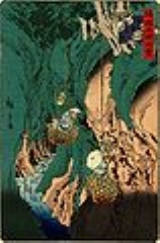
Umbilicaria esculenta
Encyclopedia

Lichen
Lichens are composite organisms consisting of a symbiotic organism composed of a fungus with a photosynthetic partner , usually either a green alga or cyanobacterium...
of the genus
Genus
In biology, a genus is a low-level taxonomic rank used in the biological classification of living and fossil organisms, which is an example of definition by genus and differentia...
Umbilicaria that grows on rocks. It can be found in East Asia
East Asia
East Asia or Eastern Asia is a subregion of Asia that can be defined in either geographical or cultural terms...
including in China
China
Chinese civilization may refer to:* China for more general discussion of the country.* Chinese culture* Greater China, the transnational community of ethnic Chinese.* History of China* Sinosphere, the area historically affected by Chinese culture...
, Japan
Japan
Japan is an island nation in East Asia. Located in the Pacific Ocean, it lies to the east of the Sea of Japan, China, North Korea, South Korea and Russia, stretching from the Sea of Okhotsk in the north to the East China Sea and Taiwan in the south...
, and Korea
Korea
Korea ) is an East Asian geographic region that is currently divided into two separate sovereign states — North Korea and South Korea. Located on the Korean Peninsula, Korea is bordered by the People's Republic of China to the northwest, Russia to the northeast, and is separated from Japan to the...
. It is edible when properly prepared and has been used as a food source and medicine. It is called iwatake (kanji: 岩茸 or 石茸) in Japanese
Japanese language
is a language spoken by over 130 million people in Japan and in Japanese emigrant communities. It is a member of the Japonic language family, which has a number of proposed relationships with other languages, none of which has gained wide acceptance among historical linguists .Japanese is an...
and seogi (hangul: 석이; hanja: 石耳; literally "stone ear" or "rock ear") in Korean
Korean language
Korean is the official language of the country Korea, in both South and North. It is also one of the two official languages in the Yanbian Korean Autonomous Prefecture in People's Republic of China. There are about 78 million Korean speakers worldwide. In the 15th century, a national writing...
.
The species name is based on the earlier basionym
Basionym
Basionym is a term used in botany, regulated by the International Code of Botanical Nomenclature...
Gyrophora esculenta.
In vitro antiviral activity
PolysaccharidePolysaccharide
Polysaccharides are long carbohydrate molecules, of repeated monomer units joined together by glycosidic bonds. They range in structure from linear to highly branched. Polysaccharides are often quite heterogeneous, containing slight modifications of the repeating unit. Depending on the structure,...
s from the lichen have been shown to inhibit replication of the HIV virus in laboratory tests.
External links
- Umbilicaria esculenta, at IndexFungorum.org
- ZipCodeZoo Zipcodezoo.com
- Gyrophora esculenta, at IndexFungorum.org
- Japanese drawings showing the harvesting of U. esculenta at Nifty.com
See also
- Rock tripeRock tripeRock tripe is a lichen of the genus Umbilicaria that grows on rocks. It can be found throughout northern parts of North America such as New England and the Rocky Mountains...

